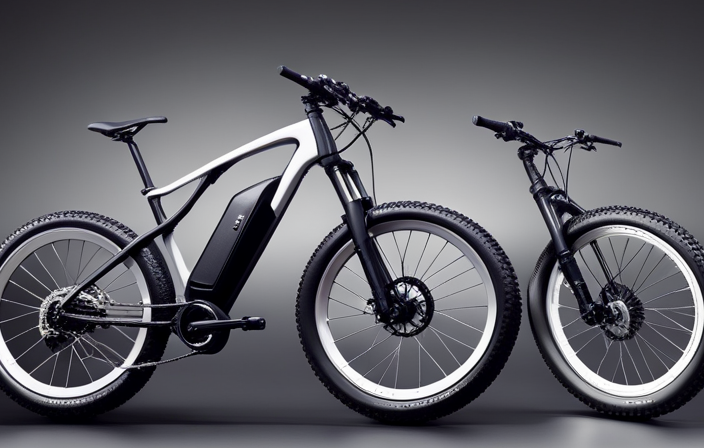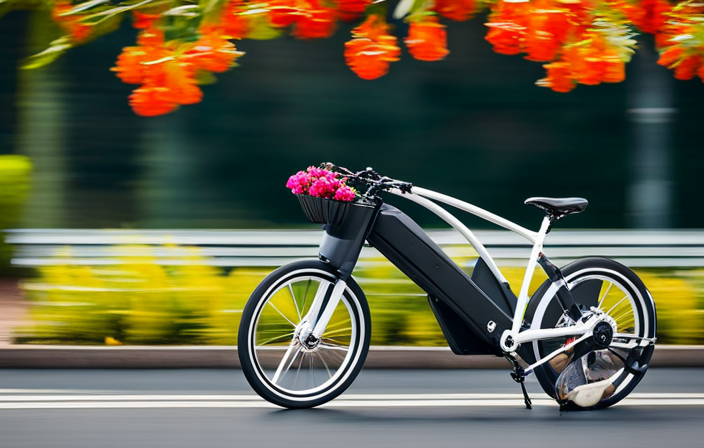Do you feel like you’re moving in slow motion? It might be a sign that your electric bike battery needs to be replaced.
In this article, we’ll dive into the world of battery capacity degradation, charging habits, and determining the overall lifespan of your battery.
We’ll also explore the signs that indicate the need for a replacement, as well as the cost and benefits of upgrading.
So, hop on and let’s find out when it’s time to give your electric bike a power boost.
Key Takeaways
- Battery capacity gradually decreases over time due to factors such as charge cycles, temperature variations, usage, and maintenance.
- Monitoring battery capacity, voltage, and current output is important to evaluate battery performance. Sudden drops in capacity, consistently low voltage and current, and increased charging time may indicate the need for battery replacement.
- Signs indicating the need for battery replacement include decreased range and power, reduction in distance traveled and power output, and inconsistencies in battery performance.
- To extend the lifespan of an electric bike battery, proper storage and maintenance are crucial. This includes storing the battery in a cool, dry place, avoiding extreme temperatures, regular cleaning and inspection for damage or corrosion, and preserving performance and capacity.
Understanding Battery Capacity Degradation
You should know that over time, your electric bike battery will gradually lose its capacity. This is a natural process known as battery capacity degradation. It occurs due to several factors, such as the number of charge cycles, temperature variations, and how the battery is used and maintained.
The capacity of a battery is measured in ampere-hours (Ah), and it indicates how much energy the battery can store. As your battery ages, it will not be able to hold as much charge as it did when it was new. This means that over time, you will notice a decrease in the range and performance of your electric bike.
Understanding this capacity degradation is important because it helps you determine when it is time to replace your battery. Now, let’s explore the impact of charging habits on battery lifespan.
Charging Habits and Their Impact on Battery Lifespan
Charging habits can significantly impact the lifespan of an e-bike battery. To ensure optimal performance and longevity, it is crucial to understand the dos and don’ts of charging your electric bike.
Firstly, avoid overcharging your battery. Leaving it connected to the charger beyond the recommended charging time can lead to premature degradation.
Secondly, avoid deep discharges. Frequent deep discharges can strain the battery and reduce its overall lifespan. Instead, aim for shallow discharges and regular recharges.
Additionally, temperature plays a vital role. Extreme heat or cold can negatively affect the battery’s capacity and performance.
Finally, it is important to use the appropriate charger provided by the manufacturer. Using an incompatible charger can result in damage to the battery.
By following these charging habits, you can maximize the lifespan of your e-bike battery.
Understanding the impact of charging habits on battery lifespan is just one aspect of determining the overall lifespan of an electric bike battery.
Determining the Overall Lifespan of an Electric Bike Battery
Understanding the impact of charging habits on battery lifespan is just one aspect of determining how long an e-bike battery will last. Several factors come into play when evaluating the overall lifespan of an electric bike battery. These factors include the battery’s chemistry, capacity, and usage patterns. To better understand these factors, let’s take a look at the following table:
| Factors | Description | Impact |
|---|---|---|
| Chemistry | The type of battery chemistry used in the e-bike battery. | Different chemistries have varying lifespans. |
| Capacity | The energy storage capacity of the battery. | Higher capacity batteries tend to have longer lifespans. |
| Usage Patterns | How the battery is used, including frequency of charging and depth of discharge. | Improper usage patterns can significantly reduce battery lifespan. |
Evaluating Battery Performance and Efficiency
Evaluating battery performance and efficiency is crucial for maximizing the lifespan of an e-bike battery. By monitoring these factors, you can ensure that your battery is functioning optimally and delivering the power you need for a smooth ride.
Start by examining the battery’s capacity, which indicates how much energy it can store. A decrease in capacity over time is normal, but a sudden drop may indicate an issue.
Additionally, consider the battery’s voltage and current output. If these values are consistently low, it could be a sign that the battery is nearing the end of its lifespan.
Pay attention to the charging time as well. If it takes significantly longer than usual to charge the battery, it may be time to consider a replacement.
Signs that Indicate the Need for Battery Replacement
When it comes to evaluating the performance of your electric bike battery, there are two key points to consider: decreased range and power, as well as inconsistencies in battery performance.
Firstly, over time, you may notice that your electric bike is not able to travel as far or maintain the same level of power as it used to, indicating a decrease in battery performance.
Additionally, you may experience inconsistencies in how your battery performs, such as sudden drops in power or unpredictable levels of charge.
These signs suggest that it may be time to consider replacing your battery to ensure optimal performance and a reliable riding experience.
Decreased range and power
If you notice a decrease in range and power, it might be time to replace your electric bike battery. As batteries age, their capacity to hold and deliver energy diminishes. This can result in a noticeable reduction in the distance you can travel on a single charge and the overall power output of your electric bike.
Factors such as the battery’s chemistry, usage patterns, and environmental conditions can all contribute to this decline. The lithium-ion batteries commonly used in electric bikes have a limited lifespan, typically ranging from 2 to 5 years depending on various factors.
When your battery starts to show signs of decreased range and power, it is a strong indicator that it needs to be replaced. However, inconsistencies in battery performance can also be attributed to other factors, which we will discuss in the next section.
Inconsistencies in battery performance
As you continue to rely on your electric bike for daily commutes or leisurely rides, you may start to notice inconsistencies in battery performance. These variations can manifest in several ways, such as sudden drops in power output or unexpected fluctuations in range.
Inconsistencies in battery performance are often indicative of underlying issues that may require attention or maintenance. One possible cause of these inconsistencies is the degradation of battery cells over time. As your electric bike battery ages, the cells may experience a reduction in their capacity to hold a charge, resulting in decreased performance.
Additionally, extreme temperature fluctuations or improper charging habits can also contribute to these inconsistencies. Understanding the factors that impact battery performance is crucial in extending the lifespan of your electric bike battery.
Extending the Lifespan of Your Electric Bike Battery
To ensure the longevity of your electric bike battery, it’s crucial to understand the importance of proper storage and maintenance.
By storing your battery in a cool, dry place and avoiding extreme temperatures, you can help preserve its overall performance and capacity.
Taking the time to regularly clean and inspect your battery for any signs of damage or corrosion will aid in maintaining its optimal functionality.
Proper storage and maintenance
For proper storage and maintenance of your electric bike battery, make sure to keep it in a cool and dry place. Extreme temperatures can negatively affect the performance and lifespan of the battery. Find a location that is not exposed to direct sunlight or excessive heat, as this can cause the battery to overheat and degrade faster.
Additionally, avoid storing the battery in a humid environment, as moisture can lead to corrosion and other damage. It is recommended to store the battery at room temperature, ideally between 20-25 degrees Celsius.
By keeping your electric bike battery in a cool and dry place, you can ensure its longevity and optimal performance.
Now, let’s move on to the next section about avoiding extreme temperatures and conditions.
Avoiding extreme temperatures and conditions
Storing the battery in a location that is not exposed to extreme temperatures will help maintain its performance and lifespan. Electric bike batteries are sensitive to temperature fluctuations, and exposing them to extreme heat or cold can cause damage and reduce their overall capacity. It is important to store the battery in a dry and cool place, ideally between 50°F and 70°F (10°C and 21°C). Extreme temperatures, whether hot or cold, can lead to premature aging and degradation of the battery cells. To emphasize this point, consider the following table:
| Extreme Temperature | Consequences |
|---|---|
| High heat | Reduced battery lifespan |
| Freezing temperatures | Decreased battery performance |
Considering the Cost and Benefits of Battery Replacement
When it comes to considering the cost and benefits of battery replacement for your electric bike, it’s important to compare the price of a new battery to that of a new e-bike altogether.
While a new battery may seem expensive, it can be a more cost-effective solution in the long run, especially if your e-bike is still in good condition.
Additionally, upgrading your battery can offer significant benefits such as increased range, improved performance, and enhanced overall riding experience.
Comparing the cost of a new battery to a new e-bike
Comparing the cost of a new battery to a new e-bike can help you determine the most cost-effective option. When considering whether to replace your electric bike battery or purchase a new e-bike altogether, there are several factors to take into account:
-
Battery Price: Check the cost of a new battery for your specific e-bike model. Compare it to the price of a new e-bike with similar specifications.
-
Battery Lifespan: Consider the remaining lifespan of your current battery. If it is nearing the end of its life, replacing it may be a better option than investing in a new e-bike.
-
Upgradability: Evaluate whether your current e-bike can accommodate a higher capacity or more advanced battery. Upgrading the battery may enhance your riding experience without the need for a completely new bike.
-
Maintenance Costs: Take into account the maintenance costs associated with your current e-bike and compare them to the potential costs of a new bike. This will help you determine the long-term financial implications of each option.
Weighing the benefits of an upgraded battery
Upgrading to a higher capacity or more advanced battery can greatly enhance your e-bike riding experience. Not only will you be able to ride for longer distances, but you’ll also enjoy improved power and performance. Here’s a comparison table that will help you understand the benefits of upgrading your e-bike battery:
| Aspect | Standard Battery | Upgraded Battery |
|---|---|---|
| Capacity | 10Ah | 15Ah |
| Range | 30 miles | 45 miles |
| Power | 250W | 350W |
| Charging Time | 4-6 hours | 3-4 hours |
| Weight | 5 lbs | 7 lbs |
As you can see, upgrading your battery will give you a higher capacity, longer range, increased power, and faster charging time. This means you’ll have more time to enjoy your rides without worrying about running out of battery power. With these benefits in mind, it’s important to consider seeking professional assistance for battery replacement, to ensure that the installation is done correctly and safely.
Seeking Professional Assistance for Battery Replacement
If you’re not comfortable doing it yourself, you can always seek professional assistance for electric bike battery replacement. A professional technician will have the necessary expertise to safely install a new battery in your electric bike. They will ensure that all the connections are secure and the battery is properly calibrated for optimal performance. Additionally, they can guide you in choosing the right battery that suits your specific needs and preferences.
By relying on professional assistance, you can have peace of mind knowing that the battery replacement process is being handled by someone with the knowledge and experience to get the job done right.
Now, let’s move on to the next topic of recycling and disposing of old electric bike batteries.
Recycling and Disposing of Old Electric Bike Batteries
When it comes to recycling and disposing of old electric bike batteries, it’s important to be aware of the proper procedures to ensure environmental sustainability. Here are four reasons why it’s crucial to handle this task responsibly:
-
Protecting the environment – By recycling your old electric bike batteries, you can prevent harmful chemicals and metals from leaching into the soil and water, reducing pollution and preserving the ecosystem.
-
Conserving resources – Recycling batteries allows valuable materials, such as lithium, cobalt, and nickel, to be recovered and reused, reducing the need for new mining and minimizing resource depletion.
-
Preventing landfill waste – Properly disposing of old batteries keeps them out of landfills, where they can release toxic substances and contribute to the growing problem of electronic waste.
-
Promoting a sustainable future – By participating in responsible recycling practices, you are supporting the development of a circular economy that prioritizes resource conservation and minimizes environmental impact.
Now that you understand the importance of recycling electric bike batteries, let’s explore battery upgrade options.
Exploring Battery Upgrade Options
If you’re looking to enhance the performance and range of your electric bike, upgrading to a higher capacity battery is a wise consideration.
With a higher capacity battery, you can expect increased power output and longer riding distances before needing to recharge.
Additionally, it’s worth exploring alternative battery technologies, such as lithium-ion or lithium polymer, which offer improved energy density and longer lifespan compared to traditional lead-acid batteries.
Upgrading to a higher capacity battery
To upgrade to a higher capacity battery, you’ll need to determine if it’s compatible with your electric bike model. Here are some key points to consider before making your decision:
-
Compatibility with your electric bike model:
-
Check the specifications of your bike to ensure that the higher capacity battery is compatible with the voltage and power requirements of your electric bike.
-
Consult the manufacturer’s guidelines or contact customer support to confirm if the battery upgrade is recommended for your specific model.
-
Performance benefits:
-
A higher capacity battery can provide you with increased range, allowing you to go on longer rides without worrying about running out of power.
-
It can also enhance the overall power output of your electric bike, giving you a boost in speed and acceleration.
Considering these factors will help you make an informed decision about upgrading to a higher capacity battery. Now, let’s explore alternative battery technologies that you should consider for your electric bike.
Considering alternative battery technologies
Consider exploring alternative battery technologies that may offer improved performance and longevity for your electric bike.
Lithium-ion batteries are commonly used in electric bikes due to their high energy density and long cycle life. However, there are other options worth considering.
One alternative is the Lithium Iron Phosphate (LiFePO4) battery, which is known for its enhanced safety features and longer lifespan.
Another option is the Nickel-Metal Hydride (NiMH) battery, which provides good energy density and is more environmentally friendly than lithium-ion batteries.
Additionally, there are emerging technologies such as solid-state batteries, which offer even higher energy density and improved safety.
These alternative battery technologies have the potential to greatly enhance the performance and longevity of your electric bike, providing you with a more reliable and efficient ride.
Conclusion
Congratulations! You’ve reached the end of this informative journey on when to replace your electric bike battery. Now armed with a wealth of knowledge, you can confidently assess your battery’s capacity degradation, charging habits, and overall lifespan.
Remember to evaluate performance and efficiency, and be vigilant for signs that indicate replacement is needed. Consider the cost and benefits of battery replacement, and don’t hesitate to seek professional assistance.
And as a responsible electric bike owner, don’t forget to recycle or dispose of old batteries properly.
Keep exploring battery upgrade options and ride on!
















